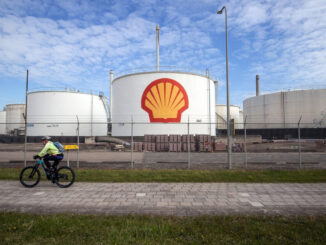
Daily Standup Top Stories
Shell and TotalEnergies Boosting Oil and Gas Output in Nigeria: A Global Trend with Financial Implications
The global energy landscape is witnessing a resurgence in oil and gas production, with major players like Shell and TotalEnergies leading the charge in Nigeria, Africa’s top oil producer. According to a recent report from […]
Shell and BP Back to Business in Libya: UK Oil Giants Follow U.S. Majors Abroad, Doubling Down on Oil and Gas
In a bold move signaling a strategic pivot, UK oil supermajors BP and Shell have inked new deals with Libya’s National Oil Corporation (NOC) to explore and develop oil and gas fields, marking a significant […]
Oil Markets Don’t Panic on the OPEC+ Production Push: Are They Maxed Out, and What Does It Mean for Global Oil Markets?
OPEC+ has been making waves with ambitious production quota hikes, signaling a bold shift toward reclaiming market share. However, recent data reveals a recurring theme: the group’s actual output consistently falls short of these lofty […]
US Cuts 2025 Crude Output Growth Forecast as Drilling Slows
Key Points The U.S. has revised its 2025 crude oil output growth forecast downward to 160,000 barrels per day, down from 210,000, due to slower drilling activity. Research suggests that major basins like Permian, Bakken, […]
The World Needs Trillions in Oil and Gas Investment to Avoid a Supply Crunch
Are We Falling Short?
Highlights of the Podcast
00:00 – Intro
01:06 – Shell and TotalEnergies Boosting Oil and Gas Output in Nigeria: A Global Trend with Financial Implications
02:27 – Shell and BP Back to Business in Libya: UK Oil Giants Follow U.S. Majors Abroad, Doubling Down on Oil and Gas
04:15 – Oil Markets Don’t Panic on the OPEC+ Production Push: Are They Maxed Out, and What Does It Mean for Global Oil Markets?
07:01 – US Cuts 2025 Crude Output Growth Forecast as Drilling Slows
09:26 – The World Needs Trillions in Oil and Gas Investment to Avoid a Supply Crunch
13:20 – Outro
Follow Michael On LinkedIn and Twitter
Need Power For Your Data Center, Hospital, or Business?
– Get in Contact With The Show –
Video Transcription edited for grammar. We disavow any errors unless they make us look better or smarter.
Stuart Turley: [00:00:00] The world needs trillions of dollars in investment to keep oil and gas flowing. That and more on the Energy Newsbeat Daily Standup. [00:00:07][6.9]
Stuart Turley: [00:00:15] Hello everybody. Welcome to the Energy Newsbeat Daily Standup. Today is July 9th. Buckle up. We got us a show. Shell and Total Energy is boosting oil and gas output in Nigeria. A global trend with financial implications. Shell& BP back in business in Libya. UK The oil giants follow US majors abroad, doubling down on oil and gas. Oiling gas markets don’t panic on the OPEC production push. Are they maxed out? What does it mean for global markets? US cuts, US crude output, growth forecast as drilling slows, and then on the energy newsbeat substack, the world needs trillions in oil and gas investment to avoid a supply crunch. Buckle up, let’s get ready to rumble. [00:01:06][51.3]
Stuart Turley: [00:01:06] First story out of the blocks, Shell and Total Energy, as Michael says, boosting an oil output with Nigeria, a global trend with financial implications. The global energy landscape is witnessing a resurgence in oil and gas production. We’re seeing this around the world like Shell and Total Energy is leading the charge in Nigeria, Africa’s top producer, according to a recent report from oilprice.com. They are ramping up their operations, which in the past had struggled to meet its OPEC 1.8 million barrels per day, but is just averaging 1.4 million barrels a day. This is actually pretty cool when you take a look at Bonga North and Ubeta Fields are expected to add substantial production by 2027, boosting upstream revenues for both companies for Shell, The Banga North project could contribute to in significantly, which is accounted for 12.1 billion in adjusted earnings in 2024. This is really, really good for investors in oil and gas. When you take a look at strategic positioning, both companies are well positioned to capitalize on a total enter J’s as well as the shell. [00:02:27][80.6]
Stuart Turley: [00:02:27] So let’s take a look at the next story here. Shell and BP back into business in Libya. UK oil giants follow US majors abroad, doubling down on oil and gas. If you’ve been on the podcast before, you’ve heard Michael and I talk about the simple fact that the United States majors, oil majors, stayed true to their course more so than did their European counterparts, Total Energies, as I had just mentioned, and Shell and BP tried to do more of the different renewable energy. And so we see that it is now changing in a bold move, signaling a strategic pivot. UK oil super majors BP and Shell have inked new deals with Libya’s National Oil Corporation to explore and develop oil gas fields, making a significant return to the North African nation after years of instability. This is critical for the overall market, but what is really critical for this is the Libyan oil is a light sweet very much like the Permian crude and for countries not wanting to do business with the United States in order to get the light sweet crude this is in direct competition with the united states oil and so it’s a good thing for competition I think it’s fabulous and this mirrors the strategy of the US Exxon Mobil and Chevron which are going abroad and as the United States and Chris Wright has been wonderful about leading the charge to become energy dominant. We’re now seeing that the European oil majors are trying to play along and follow along the United States oil and gas companies. [00:04:14][106.9]
Stuart Turley: [00:04:15] Let’s go to the next story here. Oil markets don’t panic as OPEC plus production push. Are they maxed out and what does it mean for the global oil markets. This was out of a article that I saw on oil price dot com great people over there and I went ahead and wrote this story. I also took a look at Josh Young. Josh Young on X is absolutely a must follow if you’re in the energy space. And I’ve quoted in here, Ramco raising their delivered price of oil to Asia indicates their expectations of a tight market and higher prices despite OPEX Plus decision to increase production. Josh has always got some fantastic points up here and when you take a look at the markets. Not just going down like they used to. As soon as OPEC used to announce an update, the market would immediately drop, saying there’s more supply. But we’re going, hold it, not so fast. You haven’t been able to increase production over the last three or four times, so is this just a play? Josh Young, again, is reading the market spot on. Well done. So you have to ask, is OPEC Plus maxed out? The chronic overproduction and non-compliance like Iraq, Kazakhstan, Nigeria have repeatedly exceeded their quotas, but this reflects an inability to scale back rather than surplus capacity. That is critical. And when you take a look at the difference between the United States oil drilling versus the rest of the world, the rest the world is managed by cash flow, much like the United states, but this cash flow is around governments. If the governments need extra money, they just drill more oil and they don’t care about an OPEC plus quota being established on them. They need money. Go drill. In the United States, we have this thing called mineral rights. And fiscal responsibility. ESG has done a great thing to the United States oil companies and that is both private and public are giving money back to investors so that they can have fiscal responsibility and as I love President Trump, but President Trump’s drill baby drill is not drill baby, drill whenever he says it, it’s drill baby whenever Fiscally responsible So there is a lot of fiscal responsibility going on in the United States oil markets right now. [00:07:00][165.0]
Stuart Turley: [00:07:01] Let’s go to this next story here. This is the U.S. Cut’s 2025 Crude Output Growth Forecast as drilling slows. The U. S. Has revised its 2025 crude oil output growth downward to 160,000 barrels per day downward from 210,000 barrels per day due to slower drilling activity. Research says that major basins like the Permian, Bakken, Eagleford will see varied impacts with Permian leading 6.53 million barrels per day in 2025 while others may stagnate. This is going to be critical but it also is going to play out into where best to drill because as I take a look in my day jobs either looking at oil and gas plays or each individual well analytics, We’ll take a look at well analytics. If it’s a straight horizontal, or if it’s a vertical, which one’s going to be more cost effective at a lower rate. What kind of, how many barrels are we going to expect versus how much money to outlay? And you’re going to see more of that go on as we go forward in this. The EIA data shows significant variation across the basins. For instance, the Permian is expected to brew 6.53 million barrels per day, while the Balkan and Eaglefurter projected at 1.18 and 1.15. These figures highlight the Permians dominance, but they also show the stagnation in the other areas. Now that’s only due to how the money is being inflow in the other areas. They may not need as much fracking. So those may be picking up if they’re in the pure vertical. This is something that is not in most articles. It’s going to be individual. Well, analytics is going to be more important. In the future and so that’s going to be driving where things are going to be driving and got a nice chart in here about what basin how many barrels in 2025 and then i’ve got projections in here for 2026 and you can see that it’s going to be fairly stagnant and i can see why they’re kind of alerting that it is going to be stagnant. [00:09:25][144.6]
Stuart Turley: [00:09:26] That’s where this last story comes in from the energy news beat Substack, the world needs trillions in oil and gas investment in order to avoid a supply crunch. Let’s go through these here and if you kind of saw how I was going with today’s podcast, research suggests the world need significant oil and gas investment potentially in the trillions by 2030. I’m guessing four trillion by my crayon math. It appears that the global capital expenditure for 2025 will be around 570 billion, which is below the 640, 640 billion needed by 2030. The evidence suggests top producing countries such as the U S Saudi Arabia and Russia, as well as companies, country companies like Saudi Aramco and Exxon Mobil. Are driving the production. However, investment gaps could impact supply. There’s controversy surrounding whether oil and gas will remain viable long-term investment, and I disagree. The controversy is there, but I don’t think so, because I think eventually technology will change and we won’t need as much oil and Yes. And I’m all in on the change on technology. Let’s use less oil. I’m All-in, but until the technology changes, we are going to need it. So anyway, the top producers and investments at electric. I’ve got Exxon and Chevron in here. Take a look at them always. I do not give investment advice, but talk to your advisor. If you need tax credits or you, you need, or you’re in New York. And by the way, we love New York because almost everybody in New York reads the energy news beat. I see a lot of people in New York always reading it. We love New York, but you’re tax-based. You may need an investment with tax benefits. So taxes stink. In fact, I’ve got a new coffee mug. We’ll start talking about that here in just a little bit. But I also, this is a different quote from Josh Young. So Josh Young got two quotes today. This one is gold sword. Now copper is rising rapidly, is oil next. And again, I listen to experts. [00:11:47][141.2]
Stuart Turley: [00:11:48] I listen to Doomburg, I listened to Josh Young, and I’ve got a bunch of other folks. John Brewton will be, we will be releasing John Brewton on Friday. He is the CEO of data squared and he’s in my series for AI and data center. And then I’ve got Doomberg. I’m recording in the morning with David Blackman and Mike Umbro. We’re talking about California and a crisis that’ll be followed and released the following week. This is pretty exciting stuff going on around here. And then. I’ve just confirmed. Recording next week, Jay Yu, who is the founder of Nano Nuclear and we are going to be covering about Nano Nuclear. I’ve got about five more CEOs that are lining up and we’re getting them rolling in here. [00:12:39][50.8]
Stuart Turley: [00:12:40] So thanks with that. Like subscribe. I want to give Steve Reese a shout out. Steve Reese is fantastic. If you are in the data center space, if you’re in the natural gas space, you have got to reach out to Steve Reese energy consulting.com and check them out and they can tell you how to source LNG, how to go ahead and measure it and make sure you’re making the most you possibly can in your midstream acquisitions. But if you are needing to move molecules all the way from the United States to Poland to Germany. Steve Reese is the team for you to take a look at. [00:13:20][40.1]
Stuart Turley: [00:13:20] So with that, like, subscribe, share, read this to your pets. And we hope everybody has an absolutely fantastic day. Thanks for stopping by the podcast. [00:13:20][0.0][787.3]






